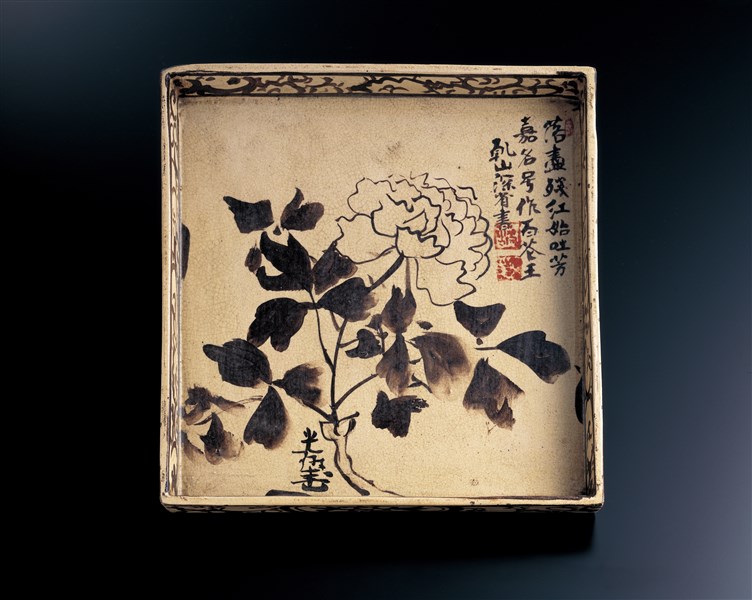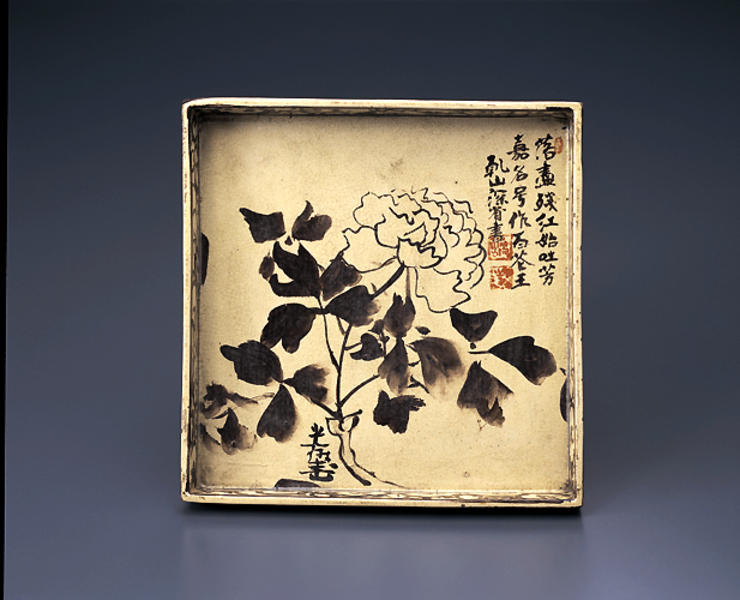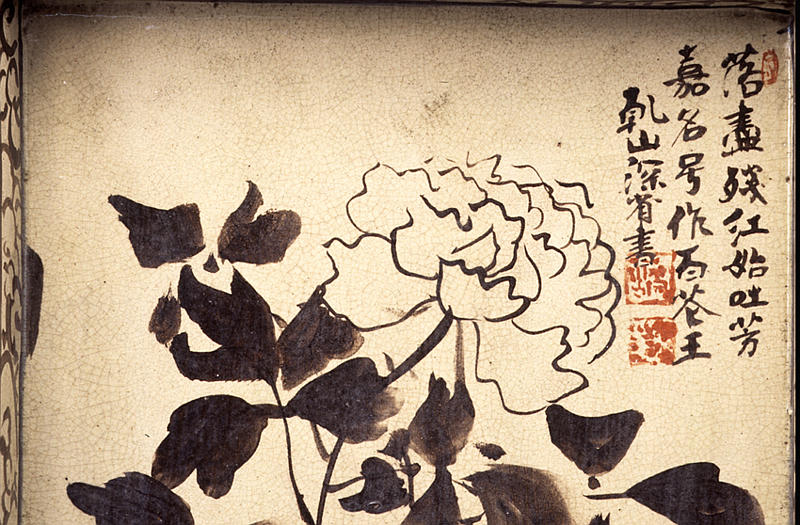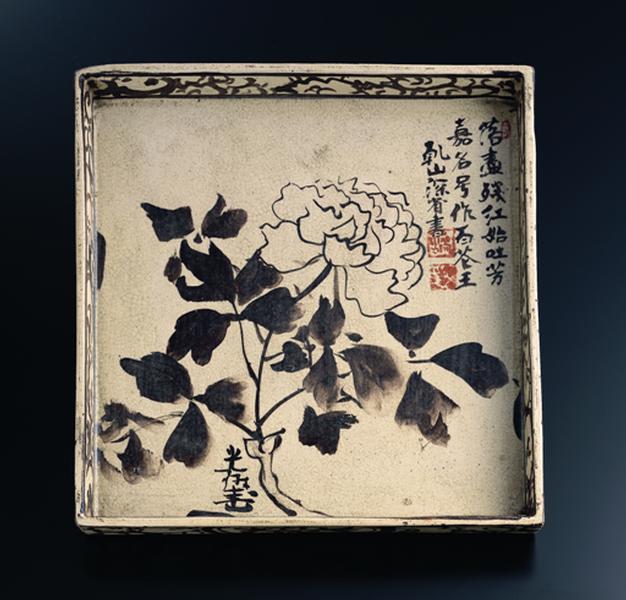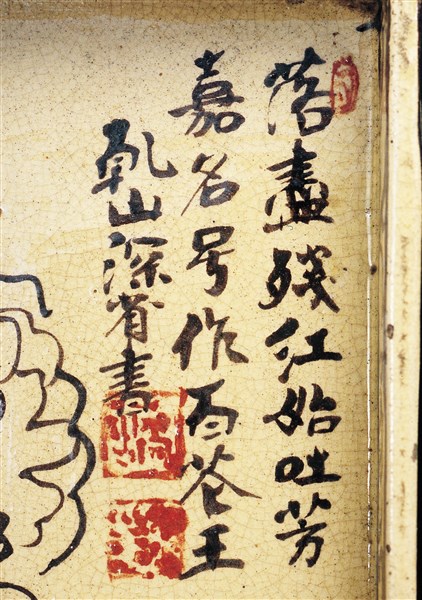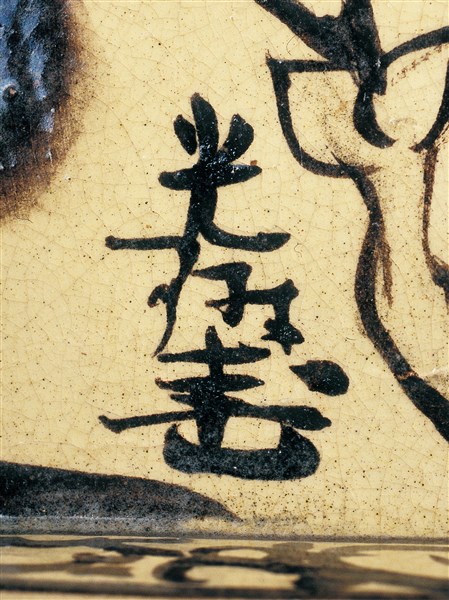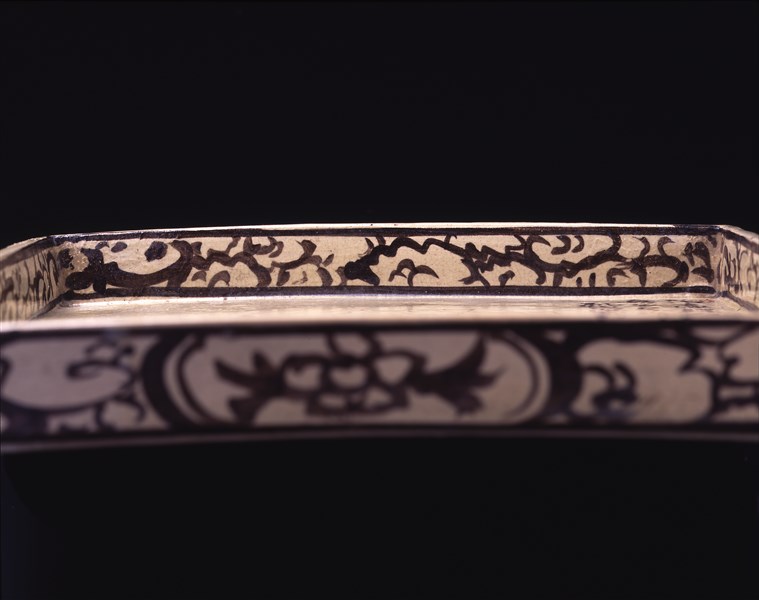乾山銹絵牡丹画角皿 尾形光琳画
- 京都・鳴滝
- 江戸時代
- 18世紀
- 乾山陶製、鉄絵
- H-3 D-22 W-21.9
江戸時代 18世紀
縦:21.9cm 横:21.9cm 高:3.0cm
器表面全面に化粧掛けされた白泥の上に,銹絵で牡丹画が描かれ,さらに透明釉が掛けられている。白泥は刷毛塗りされており,細かく観察すると,刷毛目の痕跡が見てとれる。賛に伴う印は型紙摺りで,赤の絵の具を上絵付けしたもの。牡丹画には「光琳画」賛には「乾山深省書」の落款が伴っており,光琳画乾山作,あるいは兄(光琳)弟(乾山)合作と呼ばれている角皿である。
かつて,この手のいわゆる兄弟合作の皿については,尾形乾山が著したという『陶磁製方』(佐野伝書)のなかに,「……最初之絵ハ皆々光琳自筆ニ画申候……」という記述があることから,乾山焼としては最初期の鳴滝時代の初めのものとする考え方が支配的であった。しかしその後,文書(書状)に見られる光琳の花押との対比から,兄弟合作の皿の大半を鳴滝時代の終わり頃に位置づける見解が出され,現在では有力な説となっている。 (尾野)
尾形乾山
尾形乾山(おがたけんざん 1663~1743)
乾山は、寛文3年(1663)京都の富裕な呉服商尾形宗謙(おがたそうけん)の三男として生まれました。兄は画家の光琳です。二人の性格は対象的で、光琳が派手好みであったのに対し乾山は内省的、隠遁的な性格の持主であったといわれています。
野々村仁清に陶芸を学んだ乾山は、元禄12年(1699)37歳のとき京都市の鳴滝に開窯しました。そして正徳2年(1712)50歳の乾山は、京市内の二条丁子屋町に移住し、多くの作品を手がけ「乾山焼」として世にもてはやされました。鳴滝時代の末期からこの丁子屋町時代にかけて兄の光琳は絵付で乾山を助け、兄弟合作の作品が数多く残されています。
享保16年(1731)69歳の頃に江戸に下り寛永寺(かんえいじ)領入谷(いりや)に窯を築いて晩年を送りました。そして81歳で没するまで江戸に在住し陶器や絵画の制作に手腕を発揮しました。
乾山の作品は陶芸作品のみならず書や絵画においても、俗気を脱したおおらかで文人的な洒脱味があります。陶芸作品においては成形、施釉、焼成は他の専門的な陶工に任せたり、絵付についても光琳との合作以外に複数の専門画家が携わっていたと思われるなど、基本的には工房生産という態勢をとっていたようです。しかし、乾山の指導のもとにつくられたやきものには、その大胆なデザイン感覚とともに乾山特有の芸術性が溢れ、乾山その人とふれあうような親しみが感じられるのです。
乾山銹絵染付掻落絵替汁次
乾山銹絵染付梅波文蓋物
乾山立鶴図黒茶碗
乾山銹絵染付桔梗図筒向付
乾山銹絵染付草文四方鉢
乾山銹絵染付松図茶碗
乾山色絵短冊皿
乾山銹絵絵替長平皿
乾山色絵寿字輪花向付
乾山銹絵絵替四方皿
乾山銹絵染付絵替筒向付
乾山銹絵染付松図茶碗
乾山色絵椿文向付
乾山銹絵染付春草図茶碗
乾山銹絵染付藤図向付
乾山色絵立葵図向付
乾山色絵雪杉図向付
乾山色絵桔梗文盃台
乾山銹絵馬図香合
乾山銹絵染付絵替扇形向付
乾山銹絵掻落雲唐草文大鉢
乾山銹絵草花波文水指
乾山銹絵染付絵替土器皿
乾山色絵槍梅図茶碗
乾山黒楽梅図茶碗
乾山銹絵染付芙蓉図茶碗
銹絵掻落牡丹唐草文香合
撫子図(尾形乾山筆)
乾山色絵和歌陶板
乾山色絵竜田川図向付
乾山銹絵百合形向付
乾山銹絵松文香合
乾山色絵阿蘭陀写市松文猪口
乾山色絵薄図蓋茶碗
乾山銹絵菊図水指
鶴亀図黒茶碗
紅葉図 尾形乾山筆
三十六歌仙絵/在原業平像 尾形乾山筆
三十六歌仙絵/斎宮女御像 尾形乾山筆
乾山色絵菊文手付汁次
三十六歌仙絵/小野小町像 尾形乾山筆
乾山銹絵染付山水図茶碗
Catalogue Entry
Edo period, 18th century
Kenzan ware, underglaze and overglaze decoration
Height, 21.9cm; width, 21.9cm; depth, 3.0cm
White slip has been applied to the entire exterior surface of this plate and peony blossoms painted on top of the white slip in underglaze iron. Finally, a transparent glaze was applied overall. The white slip was brushed on, and close inspection reveals traces of the brush strokes. The seal that accompanies the inscription on the painting was printed with red overglaze using a paper stencil. The peony painting is signed "Korin ga," accompanied by the statement "Kenzan shinsei sho," indicating a ceramic work created by Kenzan and decorated by Korin, his older brother.
In the past, the dominant scholarly view held that such joint works by the 2 brothers were created in the early Kenzan ware period, on the basis of the following statement in "Toji Seiho (Sano Densho)" which is said to have been written by Kenzan: "At first, all of the paintings were painted by Korin ... ." However, a comparison with Korin's kao, or written seal, found on other documents, such as letters, indicates that the majority of the plates created jointly by the brothers should be dated to around the end of the Narutaki period, and at present this is the dominant scholarly opinion. YO
尾形光琳
万治1~正徳6(1658~1716)。江戸中期の画家。装飾工芸家。京都の高級呉服商雁金屋の次男に生まれる。通称市之丞。30代半ばに光琳と称する。乾山焼で著名な尾形乾山(深省)は実弟。父宗兼や山本素軒らから狩野派の画法を学び、俵屋宗達、本阿弥光悦等から影響を受け、対象の本質をついた表現で彩色画、水墨画、蒔絵等の工芸品に至るまで器用にこなし、琳派の大成者となる。代表作に「紅白梅図屏風」(MOA美術館蔵)、「燕子花図屏風」(根津美術館蔵)、「八橋蒔絵硯箱」(東京国立博物館蔵)等がある。
瀧龍図(狩野尚信・尾形光琳合筆)
竹梅鶯図 尾形光琳筆
大黒図(尾形光琳筆)
雪中柳椿図(尾形光琳筆)
白梅図(尾形光琳筆)
群鶴流水図(尾形光琳筆)
三十六歌仙絵/小大君像 尾形光琳筆
三十六歌仙絵/源宗于像 尾形光琳筆
銹絵牡丹図角皿 光琳画
銹絵牡丹図角皿 光琳画 図録解説
表面に百花の王に相応しい瑞々しい牡丹が銹絵で画面いっぱいに描かれた、兄・光琳との合作の角皿です。色紙のような正方形、立ち上がった縁には文様が記されていることから額皿とも呼ばれます。
牡丹の葉の一部に、琳派の特徴であるたらし込み風の技法による描写が見られます。通常、素焼きの場合だと筆が引っ掛かり、紙や絹の上のように滑らかに絵筆は走りません。しかも筆をつけた途端、釉は瞬時に吸い込まれていきます。乾山の採用した全面白化粧掛けの方法は、このやきものの難点を筆致のみならず、視覚的にも紙本や絹本に描かれる絵画に近づけるためにあみ出された工夫でした。光琳が描いた絵は、「光琳深省茶碗絵手本」(東京・出光美術館蔵)に見られるように勢い余ってはみ出してしまった、そんな筆勢も感じさせるほど葉が画面からはみ出し、生き生きと描かれています。
右上に記された乾山の詩賛は如何にも窮屈そうで、茎際の「光琳(寿字型花押)」銘さえも場所がないので仕方なく記されたように見受けられます。この合作は兄弟仲の良さとともに性格の違いまでも伝えてくれるようで、どこか微笑ましく思えてきます。
Square Dish with Peony Design
Square Dish with Peony Design
A painting by Korin in underglaze iron of the auspicious peony, king of flowers, fills the surface of this dish, a collaborative work created by Kenzan and his elder brother Korin. Made with the square shape of shikishi decorative calligraphy and painting papers and with motifs on their raised rims, works of this type are also called "framed dishes."
Korin has used tarashikomi, a distinctively Rimpa technique, on part of the peony leaves, layering the pigment on surface areas still wet with paler pigment, to create an effect of pooled colors with softly blurred edges. Usually when painting on unglazed ceramics, the brush is somewhat snagged on the surface and cannot proceed as smoothly as when working on paper or silk. The pigment (the underglaze) is absorbed as soon as the brush touches the surface. Kenzan's technique of covering his works entirely in white slip not only circumvented that difficulty, making possible smooth brushwork, but also created a visual effect very similar to a painting on paper or silk. Korin’s paintings on Kenzan’s pottery sometimes were created with such energetic brushwork that they overflowed the picture plane, as in the Korin-Kenzan Patterns for Tea Bowls (Idemitsu Museum, Tokyo). We sense that vigor in this piece, in which the leaves overflow the (ceramic) picture plane.
Kenzan's poetic inscription, on the upper right, seems cramped, and the Korin signature and seal by one of the stems seems to have been placed there because nowhere else was available. This collaborative work is somehow amusing in communicating both the close ties between the brothers and the differences in their personalities.
